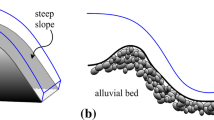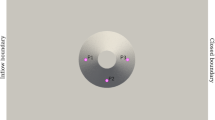
Overview
- Presents the basic open-channel flow theory as well as the modern shock-capturing methods in one book
- Focuses on the physical aspects prior to introducing any mathematical or numerical aids
- Provides numerous computational examples and compares them with experimental observations
- Offers a complete collection of steady and unsteady computer programs, provided on a CD as Vbasic macros for use in Excel, without the need for compilers
Access this book
Tax calculation will be finalised at checkout
Other ways to access
About this book
This book presents the theory and computation of open channel flows, using detailed analytical, numerical and experimental results. The fundamental equations of open channel flows are derived by means of a rigorous vertical integration of the RANS equations for turbulent flow. In turn, the hydrostatic pressure hypothesis, which forms the core of many shallow water hydraulic models, is scrutinized by analyzing its underlying assumptions. The book’s main focus is on one-dimensional models, including detailed treatments of unsteady and steady flows. The use of modern shock capturing finite difference and finite volume methods is described in detail, and the quality of solutions is carefully assessed on the basis of analytical and experimental results.
The book’s unique features include:
• Rigorous derivation of the hydrostatic-based shallow water hydraulic models
• Detailed treatment of steady open channel flows, including the computation of transcritical flow profiles
• General analysis of gate maneuvers as the solution of a Riemann problem
• Presents modern shock capturing finite volume methods for the computation of unsteady free surface flows
• Introduces readers to movable bed and sediment transport in shallow water models• Includes numerical solutions of shallow water hydraulic models for non-hydrostatic steady and unsteady free surface flows
This book is suitable for both undergraduate and graduate level students, given that the theory and numerical methods are progressively introduced starting with the basics. As supporting material, a collection of source codes written in Visual Basic and inserted as macros in Microsoft Excel® is available. The theory is implemented step-by-step in the codes, and the resulting programs are used throughout the book to produce the respective solutions.
Similar content being viewed by others
Keywords
Table of contents (12 chapters)
-
Front Matter
-
Back Matter
Authors and Affiliations
Bibliographic Information
Book Title: Shallow Water Hydraulics
Authors: Oscar Castro-Orgaz, Willi H. Hager
DOI: https://doi.org/10.1007/978-3-030-13073-2
Publisher: Springer Cham
eBook Packages: Mathematics and Statistics, Mathematics and Statistics (R0)
Copyright Information: Springer Nature Switzerland AG 2019
Hardcover ISBN: 978-3-030-13072-5Published: 20 November 2019
Softcover ISBN: 978-3-030-13075-6Published: 20 November 2020
eBook ISBN: 978-3-030-13073-2Published: 08 November 2019
Edition Number: 1
Number of Pages: XVII, 563
Topics: Mathematical Applications in the Physical Sciences, Geotechnical Engineering & Applied Earth Sciences, Geoengineering, Foundations, Hydraulics, Simulation and Modeling



